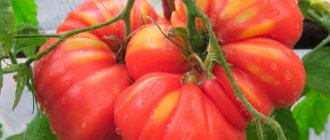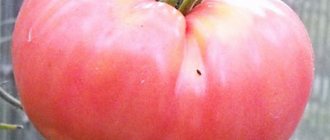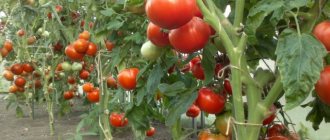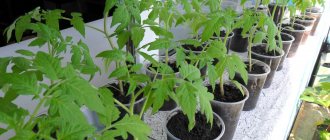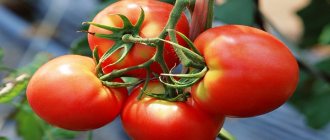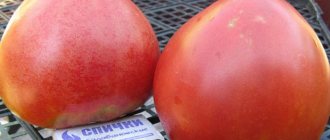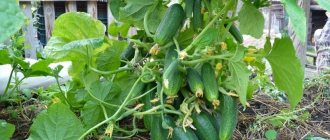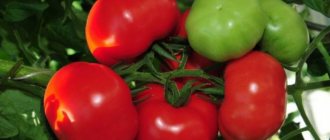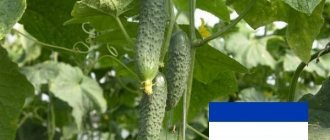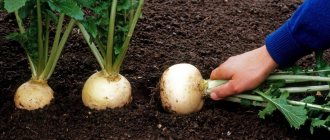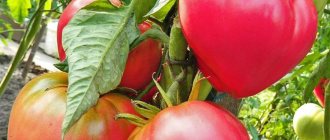Characteristics of the variety
Tomato has advantages and disadvantages. Most gardeners characterize it as a reliable variety with stable fruiting.
Advantages and disadvantages
Advantages of the variety:
- high productivity;
- large fruit;
- disease resistance;
- good taste;
- the ability to independently collect seeds for sowing.
Flaws:
- fruits are not suitable for long-term transportation and storage;
- Tomatoes are inconvenient to use for canning.
Many describe the variety as new, but it was bred by Siberian scientists in Barnaul at the end of the 20th century. Cultivated in the southern and northern regions. Suitable for growing outdoors or under cover.
The fruits begin to ripen 3.5 months after emergence.
Description of the bush
Bushes of semi-determinate type. Not many leaves. According to the description and characteristics of the variety by the producers, the plants reach a height of 0.6-0.7 meters; in a greenhouse they can grow up to 2 meters.
The variety is moderately resistant to gray rot and late blight.
Description of fruits
Fruits with a pleasant honey taste, intended for salad purposes. No sourness. A distinctive feature of plants is that tomatoes of different shapes can form on one bush:
- flat-round;
- heart-shaped.
The fruits have a good presentation. The variety is suitable for cultivation for commercial purposes.
The skin is thin and pink. The weight of one tomato reaches 800-1000 g. The average weight is 200-400 g. There are up to 6 fruits in a brush. The average yield is 4-6 kg.
The pulp is juicy, fleshy, moderately dense. There are few seeds. You can prepare seed material for sowing yourself.
On packets of “Pink Honey” tomato seeds it is often written that the fruits can gain weight up to 1.5 kg. According to reviews from experienced gardeners, the variety is indeed large-fruited, but specimens with such mass are not found.
Tomatoes Pink honey on video
If you have grown Pink Honey tomatoes, please write in the comments whether you liked them or not. What was the yield and taste of the fruits like under your climatic conditions? How do you assess the resistance of a variety to diseases? Briefly describe the advantages and disadvantages of this variety. If possible, attach a photo of the entire bush or individual fruits you grew to your comment. Thank you!
Your reviews of the Pink Honey tomato and additions to the description will help many gardeners evaluate this variety more objectively and decide whether it is worth planting or not.
If you want to see other varieties of tomatoes with large fruits, we recommend that you go to the Catalog of large-fruited tomatoes with photos and descriptions.
This is a natural variety of tomato. Therefore, we recommend taking seeds from a ripe fruit and using them for planting in subsequent seasons.
You can order seeds for 2021 from our collectors now. Catalogs have been updated.
Sowing seedlings
Sowing of seedlings begins 2 months before the expected date of planting in a permanent place. In the middle zone, seeds of plants intended for open ground are sown in late March and early April. For the greenhouse - in early March.
For sowing, choose purchased soil for seedlings or prepare a soil mixture from equal parts:
- garden, turf soil;
- sand;
- peat
Coconut substrate is considered a good option for sowing tomatoes.
For better germination, seeds are soaked in growth stimulants:
- "Energen";
- "Epin";
- "Fitosporin".
When sowing, the seeds are buried 1.5-2 cm.
After emergence, seedlings are provided with 12-16 hours of daylight. If there is a lack of sunlight, supplement the lighting with fluorescent lamps or phytolamps. On cloudy days, artificial lighting is also used during the daytime.
At first, the sprouts are kept at a temperature of 20 °C. As soon as the tomatoes grow a little, the daytime temperature is reduced to 16 °C, and the night temperature to 14 °C. Seedlings kept under such conditions are watered no more than once every 7 days.
Temperature Preferences
Plants of this variety are heat-loving, but tolerate heat with damage to the harvest. More than +35 C will lead to a stop in the pollination process of flowers and little ovaries are formed. In turn, a decrease in temperature within +15 C contributes to weak flowering and suspension of fruit set. We should not forget about growth stimulants for seeds when sowing them for seedlings, because even at this stage, resistance to diseases is developed in future plants and the likelihood of the formation of a full-fledged fruit ovary increases.
Soil and greenhouse preparation
Before transplanting the seedlings to a permanent place, the plant is hardened for 1-2 weeks in conditions close to natural - taken out onto a balcony, loggia, veranda, and a window is opened.
The soil for planting is prepared in the fall. To do this, the ground is plowed or dug up. Fertilizers are added during digging: compost, humus, and mineral preparations. Or they sow green manure.
The greenhouse is treated: washed with a brush and fungicides, hydrogen peroxide or copper sulfate added to the water.
Important! Before transplanting, seedlings are watered abundantly in the evening or at least a few hours before.
Variety resistance to diseases
One of the disadvantages of non-hybrid tomato varieties, which includes “Pink Honey,” is poor resistance to diseases. However, this fact cannot be considered a serious obstacle to the successful cultivation of such tomatoes.
Timely and proper care of plants allows you to avoid many troubles or eliminate them in time, although no one will give you a 100% guarantee of the success of these methods.
The only thing you can rely on is disease prevention
So, for example, at the first suspicion of late blight (brown spots or necrosis appear on tomato leaves), it is necessary to urgently treat all plants (no matter whether they are sick or seemingly healthy)
For this purpose, fungicidal preparations are used (for example, Ridomil). In addition, the following will help prevent the occurrence of late blight:
- compliance with the requirements for irrigation techniques (water should not fall on the leaves);
- planting tomato bushes separately from potato bushes;
- preventive treatment with a solution of Bordeaux mixture.
In the fight against gray mold or fusarium, fungicidal preparations should also be used in a timely manner. They are good not only because they treat plants, but also because they can be used for preventive purposes. The affected leaves and fruits are immediately disposed of.
“Pink honey” should be planted in those beds where legumes, cabbage or radishes grew last year, which provided the soil with the necessary microelements for the growth of tomatoes.
Large-fruited tomato varieties should be fed sparingly with organic fertilizers. For the tomatoes described above, you can use a solution of manure or chicken droppings in the proportions of 1 part fertilizer per 10-12 liters of water.
Also, during the process of seedling growth, it would be good to make two feedings of mineral fertilizers: the first on the 10th day after planting the seedlings, and the second 10-15 days after it.
For these purposes, use the following solution: add 5, 15 and 30 g of ammonium nitrate, potassium chloride and superphosphate to 10 liters of water. When applying the second fertilizing, the rate of these fertilizers is doubled. Each plant accounts for about half a glass of solution.
Despite the fact that non-hybrid varieties do not have a high level of disease resistance, this does not prevent them from being very popular among gardeners.
Therefore, if you want to protect your tomatoes from bad weather, simply plant the seedlings in a greenhouse, and all that is required for an excellent harvest is competent agricultural technology for growing the crop (proper soil preparation, compliance with the lighting regime, timely application of fertilizers and growth accelerators, hardening of seedlings, etc. .d.).
Landing rules
Planting seedlings in a greenhouse begins when the soil warms up to 14-15 °C. As a rule, under cover the soil heats up to the required temperature 3 weeks earlier than in open ground. Most summer residents plant this variety under cover in the first half of May.
Seedlings are transplanted into open ground when the likelihood of return frosts has passed - in central Russia no earlier than the first days of June, in the south - in mid-May.
Plants are planted in rows or in a checkerboard pattern. 3 bushes are placed per m². The holes are made 20-25 cm long. If the soil has not been enriched with nutrients in advance, the following is added to each planting hole:
- 1 tsp superphosphate,
- 1 liter of humus,
- ½ tbsp. ash.
The stem is buried above the cotyledon leaves. If the plants are overgrown, they are planted lying down: the stem is placed horizontally on the surface of the ground.
After planting, a watering hole is made under the bushes. To protect against fungal diseases, spill a solution with the addition of a biological fungicide - “Fitosporin”. If desired, the tree trunk area is mulched with straw, sawdust, and dry grass.
Tomato care Pink honey in open ground
Pink honey tomatoes in open ground begin to set flowers and bear fruit only at a temperature of 20 – 25°C. Favorable temperatures range from 15 to 30°C. If the weather is cool, you need to build a film shelter over the bed, which can be easily removed when it warms up. When the thermometer exceeds 35°C, pollination stops, which means there may not be a harvest.
Watering
Pink honey is a drought-resistant crop, for which excessive watering can result in diseases and a spoiled harvest. Therefore, the bushes are moistened every 10 to 14 days. But the frequency of watering can be slightly increased during the period of mass formation of fruits and in the heat. During dry periods, it is recommended to moisten the bush up to 2 times a week. But the soil should serve as a guide - water only after the top layer of soil has dried.
Pour water under the root. Do not allow moisture to get on the leaves and stem, this will cause a burn. The best time to water is early morning. Even if droplets of water fall on the leaves, it will have time to dry before the heat sets in. The drip method is ideal for watering tomatoes.
When watering tomatoes, make sure that water does not get on the leaves.
Feeding
In soil that is pre-fertilized before planting tomatoes, the Pink Honey bushes develop very quickly. But when the time comes for fruiting, nutrition becomes insufficient. During this period, you need to feed the bush at least twice. Phosphorus-potassium fertilizers affect the quality of the fruit and the speed of ripening.
If the planted seedlings are severely stunted due to lack of nutrition, be sure to feed them with nitrogen-containing fertilizers. By the way, a large amount of nutrients, including nitrogen, is contained in organic matter - manure or chicken droppings. But when using these substances you must adhere to strict rules:
Recent Entries
5 working ways to use tar in the garden 7 indoor plants that help you get married even in adulthood Indoor plants that can bloom in trouble
- 1 part of dry or fresh chicken manure is diluted in 1 liter of water and infused in a warm place for 2 to 5 days. After fermentation, the infusion is diluted with water in a ratio of 1:10;
- 500 ml of mullein is combined with 1 bucket of water and a tablespoon of nitrophoska is added. The resulting solution is used to fertilize the bushes, pouring 500 ml of fertilizer under each.
In order not to mix individual components to create a suitable fertilizer, you can use ready-made universal fertilizers for vegetables, which maintain a balance of nutrients.
The Pink honey variety is very responsive to organic feeding.
Shaping and garter
The Pink Honey variety forms the first inflorescence under the 5th – 7th leaf. Each new flower cluster appears after 2 leaves. After laying a certain number of brushes, their formation stops. Therefore, in order to increase the yield of a tomato, you need to form a bush of 2–3 stems. In addition, the tomato must be tied to a support. This must be done before large fruits begin to ripen, so that the shoots do not break under their weight.
Another procedure that must be carried out when growing this variety is pinching. Stepchildren are called shoots that grow in each leaf axil. Leaves form on it and flower buds are laid. It may seem that this is good, more fruit will be produced. Yes, there will be more fruits, but they will be, as they say, the size of peas. Therefore, in order to adjust the load on the bush, this procedure is carried out. Stepchildren are harvested by hand, carefully plucking leaves from the axils.
Stepchildren should not be allowed to grow more than 5 cm
Watering and pinching
Caring for the “Pink Honey” tomato is no different from other varieties.
- If the lower leaves touch the ground, they are removed completely or shortened when planting.
- Drip irrigation is considered the most optimal option for watering tomatoes. The procedure is carried out with 3 liters of water as the soil under the bushes dries. But not more than once every 2-3 days.
- Greenhouse tomatoes are shaken every day early in the morning and the windows are opened for ventilation. Thus, they provide them with better pollination and prevention from fungal diseases that multiply in droplets of water on the leaves.
- The stepsons are removed as they grow, leaving small “stumps” at the cut site.
Growing seedlings without diving
If you are the same supporter of growing and planting seedlings without diving in separate containers for each root, like us, then place the seeds prepared according to the general rules in the amount of three pieces in a triangle on the surface of the soil in a glass, having previously covered it with white paper cut out in the shape of a glass a napkin that should be moistened. On its surface, tomato seeds blackened by potassium permanganate will be clearly visible, which need to be sprinkled with a one and a half centimeter layer of soil and watered by spraying until moistened. These glasses should also wait for germination under glass or film.
As the seedlings grow, fill the glasses with seedling soil to the very edges. This creates conditions for the formation of additional roots in the sprouts, and their replanting into the main soil will be done by transshipment, without the slightest injury to the root system after at least a week's hardening period, if we are talking about open ground. Such seedlings bypass the period of natural wilting for pickled plants and look vigorous and grow much faster.
For any type of growing seedlings, it is necessary to water the plants regularly, not allowing the soil to dry out, and at a convenient time, after watering, be sure to feed them with an aqueous solution of complex fertilizer for seedlings twice during the period of their cultivation.
Formation
The tomato variety “Pink Honey” is formed into 2-3 stems. Despite the fact that the bushes are of small height, they require a garter. Under the weight of the fruit, the stem of the plant droops and breaks.
Plants are loosely tied to pegs or trellises using a rope made of non-rotting material. Pegs for tying are inserted immediately upon planting; later installation damages the roots.
Reviews from gardeners
Here are some reviews from gardeners about crop yields:
Elena, 57 years old, Perm: “I’ve been growing tomatoes since 2013. The fruits grow large, weighing up to 700 g. The bush must be tied up, as it reaches a height of 2 m. The taste is incomparable, it perfectly complements salads, and it also makes excellent tomato juice!”
Vladimir, 46 years old, Tomsk: “I regularly grow the Pink honey variety, the photos and yield of which were once very impressive. The bush in the open ground did not grow tall, but the fruits turned out to be quite large. The taste of tomato is sweetish and pleasant. I constantly choose new varieties, but I will undertake to grow this variety more than once.”
Lyudmila, 39 years old, Samara: “I tried different varieties of tomato. I studied reviews on various gardening forums and decided to try the much-praised Pink Honey variety. All seeds sprouted the first time, and rapid growth was observed after feeding with a superphosphate solution. The fruits grew weighing up to 500 g. The soil must be fertilized; I noticed the best growth on fertile soil.”
Prevention of diseases and pests
For prevention purposes, crop rotation is observed. Any varieties of tomatoes are returned to their original planting location after 3-4 years.
Greenhouses and greenhouses provide a constant flow of air. To avoid leaf burns on hot days, shade the plants.
Carry out regular inspection of tomatoes for signs of pests and diseases. When diseases or pests are identified, appropriate preparations (fungicides, insecticides) or traditional methods of control are used.
Tomatoes with strong signs of damage are removed completely or the diseased parts are cut off and taken outside the site.
For prevention in cold or rainy summers, the bushes are sprayed weekly with Fitosporin. At the stage of fruit formation, they are treated with copper-containing preparations. During fruiting, spray with biological fungicides 2 times a week.
Important. If the tomatoes did not suffer from diseases, after harvesting, the entire top part of the bushes is cut off with pruning shears, and the roots are left to rot in the ground. Sick tomatoes are burned completely.
Advantages and disadvantages
Pros:
- low-growing, easy to care for;
- large-fruited;
- good yield;
- has time to ripen before frost;
- tolerates short-term drought;
- excellent taste without sourness;
- The fruits are consumed fresh, made into pastes, sauces, and tomato juice.
Minuses:
- increased susceptibility to diseases;
- needs to shape the bush and tie up the fruit clusters;
- suffers from high humidity and low temperatures;
- not suitable for storage, transportation and whole-fruit seaming.
Description
Pink honey tomatoes are a medium-ripening variety.
The fruits can be called gigantic. The first fruits can weigh 1.5 kg, but later two or more copies appear on the clusters, and these tomatoes are smaller and lighter. Usually their weight is in the range of 400-800 g, but giants weighing up to 1 kg are also formed.
Photos of Pink Honey tomatoes show that they are heart-shaped with slightly pronounced ribbing. A tomato berry consists of four or more chambers. Their color is pink, sometimes there is a yellowish-green spot on the stalk.
The name Pink Honey well conveys the properties inherent in this species. Its name really reflects the color of the fruit and indicates an unusual sweet taste for this culture, strikingly reminiscent of honey. There is no sour note. Reviews from gardeners emphasize that this is one of the most delicious tomatoes.
Tomatoes are giants of sweet taste, with tender fleshy pulp, in which there are almost no seeds, in any case, there are very few of them for a berry of this size. However, the seed box is quite large, and collecting seeds does not cause any difficulty. The peel is very thin, so it is prone to cracking.
This same quality of tomatoes excludes their long-term storage and transportation.
This variety of tomato is often called salad. The excellent taste makes it possible to use the crop fresh, and the juicy pulp makes the product a suitable raw material for processing into juice, tomato paste, ketchup, adjika and other sauces. Sweet fruits are excellent raw materials for jam.
Tomatoes of this type are distinguished by a particularly high concentration of tyramine, which turns into serotonin in the human body. This chemical compound is responsible for motor activity, is involved in the regulation of cardiac tone, and is an important factor in the processes of blood clotting. Low serotonin content in the body leads to a sharp decrease in the pain threshold, when even slight pain is difficult to bear.
Canning whole fruits is not possible due to the size of the berries and the thinness of the peel, which practically cannot withstand heat treatment.
Additional care measures
While the plants are blooming, they can be sprayed with boron. This solution is prepared from the ratio: one gram of boron per liter of water. Plant foliage is treated with this product. One or two times of this feeding will be enough.
Planting of plants must be carried out without fail. This is necessary so that there are no side sprouts on the tomato shoots. The fact is that such stems need a lot of nutrition, and this does not have the best effect on the quality and quantity of fruits.
The first time the stepsons must be removed below the flower brush. The length is usually about five centimeters. This procedure should be done early in the morning. The weather should be dry and warm. The bush is formed into a pair of stems. You need to trim the bushes manually. This procedure is repeated every ten days.
Tomato bushes must be tied to a support that is installed in the ground. This is necessary so that the plant does not feel too heavy under the weight of a large number of fruits. The bush will not break and will grow straight. In addition, in open ground conditions this measure helps plants better cope with rainy and windy weather. Let's say a few words about how to protect tomato plantings from harmful insects and various diseases. First of all, you must follow all the basic rules for planting and caring for plants. If you see traces of fungal diseases on the plants, then it is necessary to apply fungicides. For example, Ridomil. If your plantings are bothered by harmful insects, then you need to use insecticides.
If the growing conditions are not very favorable, then the risk that gray rot, late blight or another disease will rampage through your plants becomes higher. This usually concerns too high humidity levels, poor ventilation, low temperatures, and dense planting patterns.
Pest Control
In some unfavorable years, a tomato may suffer from attacks by insect pests. The most common ones are described in detail below.
Medvedka
Widespread soil pest. With the help of strong horny jaws, the mole cricket very easily gnaws even the largest roots. After this, damaged plants are easily pulled out of the ground. When widespread, the mole cricket can destroy up to 90% of plants. The most effective way to control mole crickets is to use insecticides. For example, you can use Medvetox granules. They are introduced into moist soil at the locations of the passages.
